Efforts to improve road safety have resulted in warning lights that have made moving vehicles more visible. First running lights daylight appeared about 40 years ago in the Scandinavian countries, where, due to climatic features, there is often not enough natural light during daylight hours.
Decades later, the presence of running lights on a car has become a mandatory item of the rules. road traffic(SDA) of most countries of the world, thereby proving its effectiveness. This article will tell you about what daytime running lights are and everything connected with them.
What is DRL?
Daytime running lights (DRL) are lights located in the front of the vehicle. They are intended for daytime use. DRLs significantly improve the visibility of a moving vehicle (TC), thereby reducing the risk of emergencies. In the English language interpretation, DRL is referred to as DRL (Daytime running lights). This abbreviation is often found on packages with commercially available navigation lights.
GOST and DRL
The installation of lighting and light signaling devices on the vehicle is regulated by the GOST R 41.48-2004 standard. Section 6.19 "Daytime running light" clearly specifies the norms for the placement of lighting devices, their geometric visibility and functional connection diagram. In particular, clause 6.19.5 says that the emitted light should come at an angle:
- in the horizontal plane - 20 °;
- in the vertical plane - 10 °.
It is this point that drivers often violate when making and securing DRLs with their own hands. As a result, the light is either directed into the asphalt, without attracting the attention of oncoming motorists, or it blinds them too much.
The permissible distances for the placement of navigation lights are clearly shown in the figure. 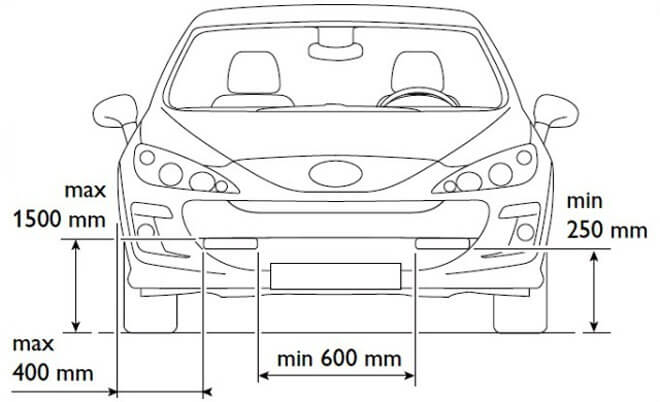 Turning on (off) running lights should be carried out automatically when starting (stopping) the engine (clause 6.19.7). also in electrical diagram should be considered automatic shutdown DRL at the moment when the headlights are turned on.
Turning on (off) running lights should be carried out automatically when starting (stopping) the engine (clause 6.19.7). also in electrical diagram should be considered automatic shutdown DRL at the moment when the headlights are turned on.
Traffic rules and daytime running lights
In Russia, at the legislative level, the mandatory use of DRL was approved in November 2010. In this regard, the traffic rules were supplemented with amendments, according to which all moving vehicles must have DRLs turned on, or dipped headlights, or fog lights.
The choice of a light source that performs the function of navigation lights is largely determined by design features the car and its year of manufacture. Modern car models are equipped with standard notification devices based on LED modules. The use of such DRLs significantly saves fuel consumption and battery energy when driving in urban areas.
For this reason, many car owners install ready-made modular DRLs on their own or make them with their own hands, getting rid of the shortcomings of low beam and fog lights. Turning on the dipped headlights activates the backlight dashboard and dimensions, as a result of which the load on the battery increases and the lamp life is shortened. In turn, fog lights blind drivers of oncoming traffic, which is their main disadvantage. For this reason, in many countries it is prohibited to turn them on under normal visibility conditions.
Clause 12.5 of the Code of Administrative Offenses of the Russian Federation contains information on malfunctions and conditions under which the operation of the vehicle is prohibited. In particular, it is forbidden to install lighting devices, the operating mode of which does not meet the basic requirements of the Regulation, which entails deprivation of rights for a period of 6 to 12 months.
Special vigilance should be exercised by drivers of public transport, as well as when transporting children, dangerous and oversized cargo. In accordance with Art. 12.20 of the Code of Administrative Offenses on the territory of the Russian Federation for driving in the daytime with DRL turned off, a warning or a fine of 500 rubles is provided.
Installation and connection of DRL
Adhering to the layout scheme, it is quite possible to install the running lights on a car with your own hands. The complete set of industrially produced models, as a rule, provides for the presence of a description and parts for quick installation and connection with onboard network cars.  But with self-made daytime running lights, you have to tinker with. Particular attention must be paid to the quality and correctness of the connection in order to avoid troubles with electrical wiring in the future.
But with self-made daytime running lights, you have to tinker with. Particular attention must be paid to the quality and correctness of the connection in order to avoid troubles with electrical wiring in the future.
As for the ready-made assemblies, Philips LED DRLs have proven themselves well. They favorably differ in ease of installation, are suitable for many brands of cars, have a shock-resistant case and a long service life.  Their only drawback is the price, which ranges from $ 60 to $ 100 per pair. Summing up, I would like to note that today the daytime running lights on a car are a tandem consisting of practicality and safety. Due to their purpose, the car stands out from the general moving stream, and their light prevents potential accidents.
Their only drawback is the price, which ranges from $ 60 to $ 100 per pair. Summing up, I would like to note that today the daytime running lights on a car are a tandem consisting of practicality and safety. Due to their purpose, the car stands out from the general moving stream, and their light prevents potential accidents.
Read the same
In 2010, the road traffic regulations were amended, according to which all vehicles in daytime days must drive with the running lights on.
If the car is not equipped with such lighting means, it is necessary either to install them, observing the requirements of GOST, or to drive with the dipped beam or fog lights on.
Why do you need daytime running lights
A car that has its running lights on gets a lot more attention than a car without the headlights on. Lighting allows other road users and pedestrians to notice the vehicle from afar and avoid accidents.
It is because of this that in 2010 it was decided to add a corresponding rule to the traffic rules.
If the vehicle is not equipped with running lights, the driver can avoid liability by using fog lights or low beam.
When comparing daytime running lights with standard headlights found in any car, the former have a number of advantages. Low power consumption is one such advantage.
In order for the headlights of a car to illuminate the road, they consume electricity, which is generated by the generator. In turn, the generator, while the car is moving, receives energy from the battery. In this case, the standard vehicle lighting is not energy-intensive.
Another thing is when the car moves through the city, where there are constant traffic jams, traffic lights and pedestrian crossings... In this case, the generator does not have time to recharge the battery, which negatively affects the power supply system of the machine. If we are talking about an old car with a poorly functioning battery, then after a few such trips it may fail, at the same time adding to the car owner problems with wiring.
Daytime running lights consume much less energy. It is for this reason that in most new cars such lighting systems are installed at the factory and are included in standard equipment auto.
The side lights also consume a little energy, but their illumination is not sufficient for driving, they will simply be invisible. It is also better to use daytime running lights instead.
GOST for DRL in Russia
The last regulatory legal document governing the rules for choosing a DRL for a car is GOST. In accordance with the requirements of this act, daytime running lights installed on cars in the Russian Federation must meet the following requirements:
- The height of the lights to the ground should be between 25-150 centimeters.
- The minimum distance between the light units is 60 centimeters.
- The total area of the emitters should be no more than 200 centimeters.
- The total light emission should not exceed 800 Cd.
The only drawback of installing daytime running lights in accordance with the requirements of GOST on old cars is the need for mechanical intervention in the design of the vehicle bumper. Only a professional who will have to make cuts and other installation work can cope with such work.
 Daytime running lights, traffic rules
Daytime running lights, traffic rules
In accordance with the requirements of road traffic regulations, every car driving both within the city and outside it must have daytime running lights on. In their absence, it is allowed to turn on the dipped beam or fog lamps. Only by observing these requirements, the motorist can ensure the safety of other road users and pedestrians. If this rule is not followed, the driver of the car.
The traffic rules provide for cases when the use of DRL is mandatory:
- If the car is transporting a minor child.
- When moving on motor vehicles, it is also necessary to always turn on the daytime running lights, since other lighting will be poorly visible.
- DRL must be included when transporting oversized items or items posing a hazard (explosives).
- To attract attention, DRL should be used by public transport and minibuses.
Requirements for navigation lights
In addition to the rules for placing DRLs, GOST contains the characteristics that all daytime running lights used in Russia must meet.
DRL parameters:
- Only white lights are allowed. Any color DRL will be penalized.
- GOST does not regulate the light source, therefore, the motorist can choose it at his discretion (incandescent lamps, LED lamps, gas-discharge lamps).
 GOST also contains requirements for the mode of operation of daytime running lights:
GOST also contains requirements for the mode of operation of daytime running lights:
- It is necessary that the lights turn on simultaneously with the ignition.
- The lights should go out at the same time as the main lighting is turned on. The only exceptions are when headlights are used to give warning signals.
Self-installation of daytime running lights, without obtaining permission from the traffic police, can lead to a fine with confiscation of lighting devices that do not correspond to the configuration of the car. To avoid liability, you must seek the advice of a specialist who can install a DRL that clearly meets the requirements of the law.
Even if DRLs are installed independently and with minor violations of GOST, which the road inspection officers will not notice when checking documents, the fact illegal installation daytime running lights that do not correspond to the configuration of the car will be detected at the first technical inspection, which will entail additional money and time.
We all remember that in 2010 a new requirement appeared in the traffic rules, which caused a lot of controversy and misunderstanding among drivers - at any time of the year during the day it is obligatory to turn on daytime running lights, if they are not provided, then either fog lights should be lit.
This innovation was motivated by the fact that with the DRL or low beam turned on, the car will be very easy to notice with peripheral vision both in urban areas and outside it. We have already described in detail on our auto portal the site and what requirements are put forward in the traffic police for running lights.
Despite the fact that this amendment began to be applied more than four years ago, many drivers are interested in the question - what are daytime running lights (DRL), is it possible to use instead of them, for example, dimensions or do you need to somehow modify the head optics system, connect LED lights and so on.
The question is really serious, especially since fine for violation - 500 rubles... There is also a fine for non-compliance of optics with the requirements of GOST, again, you will have to pay 500 rubles.
The situation is further complicated by the fact that in the design of many cars there are no special running lights and drivers have to constantly turn on the dipped beam or fog lights (traffic rules clause 19.4). On the track, the energy generated by the generator is enough to keep the headlights on. But in constant city traffic jams, when driving on low revs the alternator is not producing enough electricity and the voltmeter indicates that the battery is starting to discharge. Accordingly, its resource and service life are reduced. Owners of domestic cars, for example, VAZ 2106, face such a problem.
At the same time, the traffic police declare directly that DRL is not dimensions, sidelights and various artisanal lighting devices installed without approval.
Parking lights have low power and are practically invisible during daylight hours, therefore, they are not allowed to be used as such.
And for the installation of devices not provided for by the regulations, a fine is also imposed.
Definition of DRL
To deal with the issue, let's look at Technical regulations on the safety of wheeled Vehicle ... In it we will find all the information that interests us.
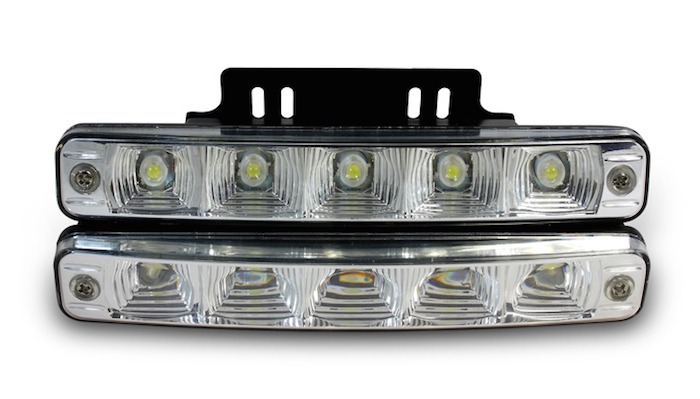
First, we see the definition of DRL:
- “These are TS lamps, which are installed in its front part, not lower than 25 centimeters above the ground and not higher than 1.5 meters. The distance between them must be at least 60 centimeters, and the distance from them to the extreme point of the vehicle must not be more than 40 centimeters. They are directed straight ahead, turn on at the same time as the ignition is turned on and turn off when switching to low beam headlights. "
Also in this document they write that if the design of the DRL is not provided for, the dipped beam or fog lights must constantly - at any time of the year in the daytime - be lit.
Drivers are advised to use LEDs as they consume 10 times less energy than halogen or conventional filament bulbs. Almost all modern cars have LED daytime running lights.
The document also states that it is possible to purchase special, officially approved sets of lamps for installation on front bumper... Below are several applications, which say, in particular, that the installation of LED lights, if they are not provided for in the original design of the car, is optional - that is, optional. But in this case, dipped headlights must be used as DRL.
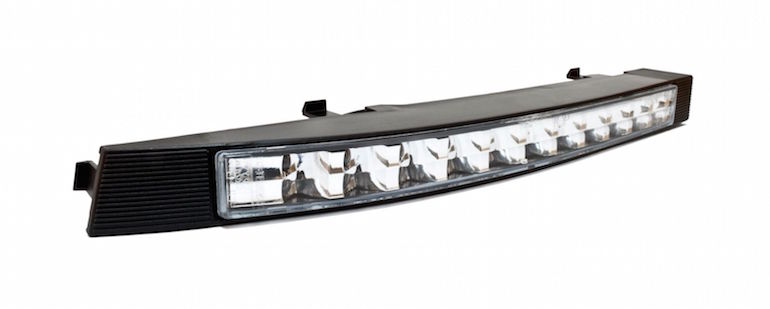
The appendices also explain in more detail the rules for installing daytime running lights on vehicles with different overall dimensions... We will not give these explanations, because they are very easy to find.
There is also one more important circumstance - daytime running lights must emit white light. Its slight deviations towards other colors of the spectrum are allowed - blue, yellow, green, violet, red.
SDA on daytime running lights
To get an even better understanding of this issue, you can open the Traffic Rules of the Russian Federation and find paragraph 19.5. We will find a lot of useful information here.
First of all, DRLs are needed to ensure the visibility of vehicles and the safety of both drivers and pedestrians. If drivers neglect this requirement, then according to the Code of Administrative Offenses 12.20 they must prepare to pay a fine of 500 rubles.

The next point is the rationale for this requirement:
- motorcycles and mopeds - it is difficult to see from afar, and with DRL turned on they will be easily distinguishable;
- route vehicles - to warn other road users about their approach, to prevent rash actions by other drivers;
- attention is especially focused on the transportation of children;
- be sure to include DRL during transportation dangerous goods, oversized and so on.
Thus, from the traffic rules we can conclude that this requirement for the use of DRL really makes sense and must be adhered to. In addition, in the event of an accident, the culprit will always be able to appeal to the fact that due to the fact that the daytime running lights of the victim did not burn, he simply did not notice him.
Can I install daytime running lights myself?
The topic of daytime running lights is quite relevant among car enthusiasts. Many drivers assemble these systems with their own hands in order to save money. There are many such homemade options, which are more elements of tuning than a functional solution. These products will not be useful, and sometimes they can be harmful. Such lights are often made from any materials at hand. Also on the market you can find many models from China.
Many still believe in the power the latest technologies and, due to a weak orientation in these technologies, they fall for the marketing tricks of the Chinese brothers, who indicate more high performance than they really are. It is worth finding out how to choose running lights on a car, which models are considered the best and what car owners write about them. The topic of installation and connection is also very important.
Functions of daytime running lights
DRLs are designed to mark a vehicle on the road during the day. There is a regulation that states that the glow should be at an angle of 30 degrees, where 10 should be above the horizontal, and another 20 below. According to the same regulations, the illuminated area should be about 40 cm 2 - this will help to avoid buying not very efficient light sources. These are often models with spot light.
Those who know how to choose buy equipment, the light of which is already visible from a distance of up to 200 m, even on a clear and sunny day. DRLs, unlike automotive optics, have a smaller glow angle. According to their tasks, these light sources should create the effect of a lantern that shines into a person's eyes from a long distance.
Types of daytime running lights
In different countries, the types of these lighting devices are understood completely differently. It may well be the low beam, which turns on when the engine starts. To reduce the intensity of the glow, it operates at a lower voltage.
A distinction is also made between front emitters or turn lamps, independent of the electronic filling of the car, which work constantly. But this confuses other drivers and can lead to an emergency.
In Russia, from November 20, 2010, the traffic rules indicate the need to use DRL at any time of the day or night and on any roads. Anything can be used as running lights, up to low beam or fog lights. 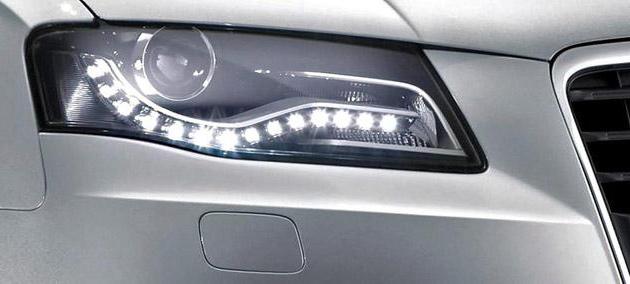 By the way, the latter perfectly illuminate the roadside. Their light is quite bright, and the car with them becomes more noticeable on the road in any conditions. But they also have a serious drawback. can blind other road users.
By the way, the latter perfectly illuminate the roadside. Their light is quite bright, and the car with them becomes more noticeable on the road in any conditions. But they also have a serious drawback. can blind other road users.
In Canada and the United States, it is allowed to use high beam, but dimmed, as navigation lights. Some manufacturers specifically install optics with high beam with reduced pressure.
Running lights are, first of all, traffic safety, so you should not save on this equipment or create an absurd design with your own hands. If you know how to choose the right daytime running lights, you can get an inexpensive and effective kit.
Choosing LED lights
Such DRLs are very effective method car signs on the road. This is a spectacular tuning, and also an opportunity to avoid fines. Today DRLs are a very relevant norm. passive safety... Statistics show that with their introduction, the rate of road accidents on the roads of the country has significantly decreased.
For those who do not know how to choose LED daytime running lights, preference should be given to models where the light is stable, bright and powerful enough. But first things first.
Why LEDs? Because their brightness is much higher than the most common daylight. LED kits are in great demand today. They are visible in all conditions, even in the brightest sun.
For those who do not know how to choose running lights on a car, it is worth saying that the blocks have certain characteristics. It is on them that the choice should be based. Below we will consider the main characteristics of DRL units.
Shape, size, design
So, one of the characteristics is shape and size. Running light kits can have different parameters and look like two replaceable or non-replaceable components. As for the design, it all depends on the designers. 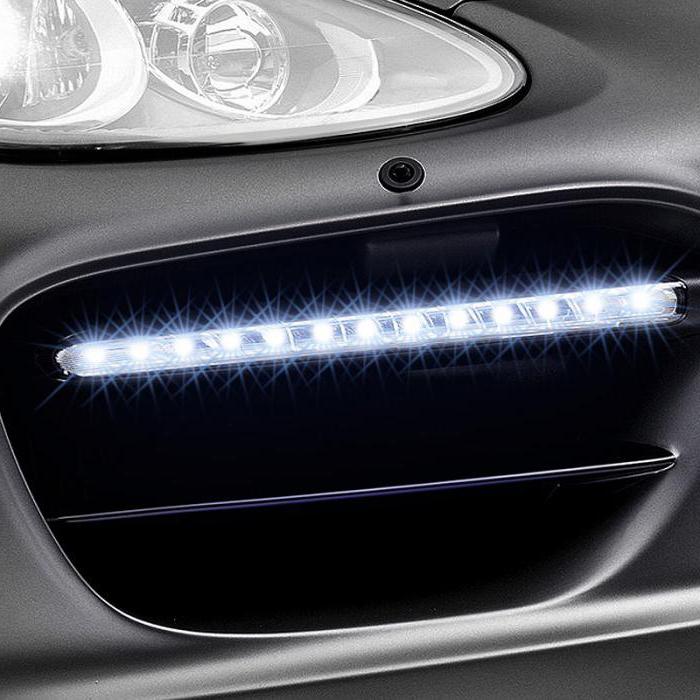 Modern models can be not only classic, but also curved, triangular or any other. The main criterion in the choice in terms of shape and size is the bumper, its design features. Also important is the place where the DRLs will be installed.
Modern models can be not only classic, but also curved, triangular or any other. The main criterion in the choice in terms of shape and size is the bumper, its design features. Also important is the place where the DRLs will be installed.
Number of LEDs
Often the system consists of two blocks. Each of them may contain a number of diodes. This amount affects the brightness of the glow, as well as appearance... Some models may have from 1 to 12 diodes per block. In the standard version, 5 diodes are available, but this solution is not suitable for all models and brands of cars.
Diode arrangement
LEDs can be mounted at the top, bottom or in the middle. On most models, manufacturers use the latter option, but there are also non-standard devices on sale.
Luminous flux intensity
For those who do not know how to choose running lights on a car, it is worth saying that when choosing it is important to maintain a balance between day and night.  If the LED is sufficiently bright, then during the day it will be able to increase the visibility of the DRL, at night a bright element will blind the driver. Today, most models have begun to use special microcontrollers that regulate the brightness.
If the LED is sufficiently bright, then during the day it will be able to increase the visibility of the DRL, at night a bright element will blind the driver. Today, most models have begun to use special microcontrollers that regulate the brightness.
Types of LED DRL
LED daytime running lights can be divided into universal and standard. The first ones are created for most models and brands of cars. These systems are quite unpretentious, and even a child can install them. For those who do not know how to choose running lights on a car, this is a good option.
Standard solutions are specially created for a specific make and model of a car. Both the first and the second type are produced by several well-known brands around the world. Thanks to this, you can easily find the right set for any budget. There is another classification - according to it, the running lights are divided into external solutions and with installation directly into the head optics.
So, external ones are installed in a separate case. Their main advantage is simpler installation and low price. Self-installation and connection is also possible. But they are very vulnerable to various mechanical damage and have an unremarkable appearance.
The second option makes it possible to use sufficiently powerful light sources, but at the same time completely preserve the design of the car, which was developed at the factory. Installation of these solutions requires a specialist to comply with some important rules, as well as time and money.
Advantages and Disadvantages of LED Running Lights
Among the advantages of such solutions, one can single out an increase in the level of safety on the roadway, a significant reduction in accidents. Also these kits have minimal energy consumption. The diodes have a long life and the system wear is practically zero.  Daytime running lights and an auto-controller make the driver's life much easier - no intervention is required from the car owner.
Daytime running lights and an auto-controller make the driver's life much easier - no intervention is required from the car owner.
On sale there are many models of different shapes, sizes, characteristics that are suitable for almost any conditions. Installation of systems is simple. DRL maintenance is practically not required, and the light does not blind drivers.
Among the disadvantages is the cost, because it is simply impossible to buy a quality product cheaply. Reliable, durable and quality kits require an investment. However, such investments will quickly pay off, because the life of the dipped beam lamps will remain.
Another disadvantage is that some car models do not have connectors. However, this problem can be solved with minimal effort. You can install running lights on a car with your own hands. The connection diagram is very simple and straightforward. 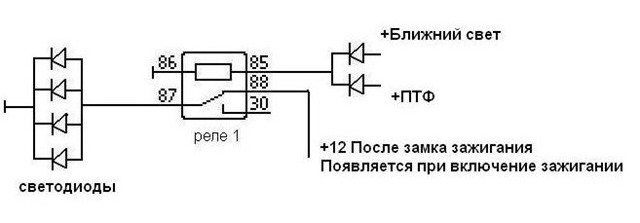
Market Review
What are the good and best DRLs? Do they exist at all? Let's try to find out. We'll start with Chinese brands. So, these lights have already turned from novelty to commonplace. Some car enthusiasts prefer Chinese models, others buy expensive products from Hella or Philips. It is believed that everything that is made in China is nonsense. It's not like that at all. Among the Chinese, there are both decent and honest manufacturers.
How to choose running lights on a car
Often car enthusiasts are offered "eagle or something like that. At first glance, it may seem that these are the best solutions. But most of the cars are distinguished by terrible wiring and poor-quality aluminum casing. The trouble with such structures is the lack of heat dissipation. As a result, the diodes" degrade " If these are the lights you want, then the Hella models are worth getting. They are the best. They are expensive but well worth it.
There are also flexible band running lights. These devices are most often made by the Chinese. They cannot be called the best. And they are frankly weak as navigation lights. There are no aluminum boards or even heatsinks here. A plus is tightness, and they are only suitable for Hella has already begun to develop similar headlights - it is worth waiting for the release of a high-quality model.
They also offer running lights in housings with plastic glass. Everything here is very ambiguous. You can purchase good model or run into a fake. And this is now not only about Chinese products, but also about well-known manufacturers. The first generation Philips navigation lights had excellent performance however, due to overheating and poor heat dissipation, the plastic glass simply melted.
Lights are also sold in a case with lensed glass. This is the preferred solution. If someone does not know which daytime running lights are better for a car, then this is the one the best choice... Manufacturers include Philips, Osram and others. There is glass and aluminum, and this is the best combination.
Plate-shaped LED DRLs are something to avoid. They are only good for illumination. There is no protection from dust, liquids, a radiator. Service life - 3 months with intensive use.
The lights that can be installed in the fog lights are the best they have to offer. Here 10 W LED, lenticular glass, aluminum body and universal mounts.
The best DRL running lights: review and reviews
This review should start with brands from the Middle Kingdom, or more precisely, from Aliexpress. There are terrible kits on the site, but there are also some good, if not the best, DRLs. Good Chinese lights won't come cheap.
Golden DRL Road type 2015
These are some of the best running lights from the brothers from the Middle Kingdom. Model from 2015. The body is made of aluminum. The manufacturer claims that this solution can be used as a fog lamp, but this is not the case.
There are practically no downsides to this DRL. The power of each unit is 10 W. 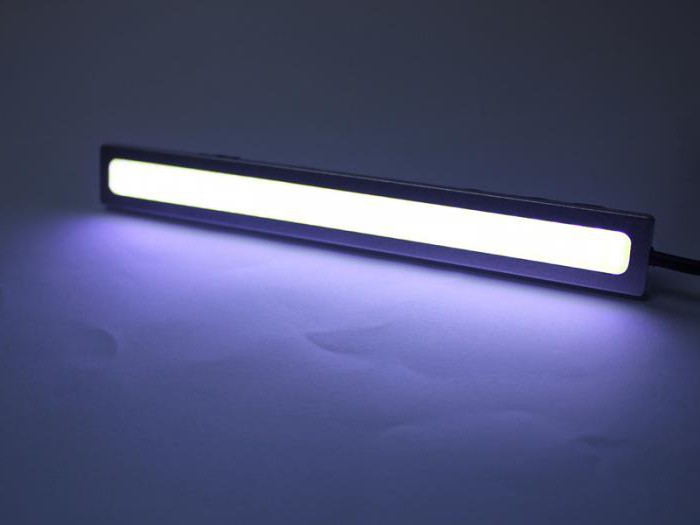 There are two color temperature modifications. It is a warm white glow of 3000 K and a cold white one with a temperature of 6000 K. The device has excellent heat dissipation. The brightness of the stream is 980 lm.
There are two color temperature modifications. It is a warm white glow of 3000 K and a cold white one with a temperature of 6000 K. The device has excellent heat dissipation. The brightness of the stream is 980 lm.
The model is preferable, but it will not fit all models. As for the reviews, they say that the car is marked with them perfectly. The glow can be seen already from a distance of 180 meters. The opening angle complies with domestic regulations. The price is 700 rubles per block.
Philips Daylight 9
This solution is one of the best, but already from a global brand. The model has all the necessary characteristics. It combines good design and excellent visibility. This model can be installed on most cars.
The blocks use 9 diodes. Together with the latest lenticular optics, the angle of illumination of the road is quite large. Installation is very simple. Special latches will prevent theft of modules.
The modules are equipped with electronics that are compatible with most types of transport, including electric cars. The body is traditionally made of aluminum and the lenses are carefully polished. Car owners using such products say that the light is very bright and the body does not heat up at all. Price - from 3500 to 5000 rubles. Now it is clear how to choose DRL. Running lights and dipped beam are a necessary part of any car, because safety depends on it.
So, we found out what daytime running lights are, which ones are better to choose and how much they cost.
V modern car installed as many as 8 different lighting devices (there is also a rear license plate backlight, but in this case we are not interested in it). And these 7 lighting devices: headlights, lanterns, foglights and others, we need to use in different ways, depending on as many as 8 conditions. Let's list the lighting fixtures and their terms of use for 2017!
So, there are so-called external lighting devices in the car. These include:
- headlights: low beam;
- headlights: high beam;
- rear lights;
- fog lights (PTF);
- rear fog lights;
- parking lights;
- daytime running lights (DRL).
And among the conditions for the inclusion of certain lighting devices in traffic rules, there are the following:
- daylight hours;
- dark time days: illuminated road;
- dark time of day: unlit road;
- poor visibility conditions;
- standing / moving car;
- trailer / towed car;
- locality / non-locality.
Scared? In fact, not everything is so scary. Let's find out when and in what cases you need to turn on fog lights, high or low beam headlights and dimensions. Data is current as of September 1, 2017. For convenience, we will consider the rules for using a car light, depending on the time of day and other conditions, and answer some pressing questions. And at the end of the article, we will give a table as an easy way to remember when which lighting devices need to be turned on on the car.
What kind of light to use during the day?
During the day, namely, during the daytime, we can use daytime running lights (19.5 SDA). But instead of DRLs (not only if they are not installed in the car, but also at the request of the driver), you can use dipped headlights or fog lights (19.4 + 19.5 SDA).
During daylight hours (provided that there are no conditions of insufficient visibility), you need to include:
- Daytime Running Lights;
- dipped headlights;
- fog lights (but not in conjunction with low beam or DRL).
During daylight hours, you cannot turn on:
- high beam headlights;

What kind of light to use in the dark?
The dark time of the day in the SDA is defined as "the period of time from the end of the evening twilight to the beginning of the morning twilight" (1.2 SDA). Thus, in the dark hours of the day, night is completely included, evening from the end of twilight and morning until the beginning of dawn.
In the dark, you need to include:
- low or high beam headlights in motion (see below under what conditions the high beam must not be used);
- parking lights when stopping or parking on the road, as well as on trailers and towed vehicles;
- fog lights - only on unlit sections of the road and only in conjunction with low or high beam headlights.
Also, in the dark, you can turn on, if you have a special headlamp-spotlight, provided you move outside the village and in the absence of oncoming cars.
In the dark, it is forbidden to use:
- high beam headlights:
- in settlements, if the road is lit,
- if oncoming traffic is closer than 150 meters to you, or even if farther and at the same time blinks your headlights,
- in any other cases when it is possible to blind the drivers (drivers, not pedestrians) of oncoming and passing vehicles;
- fog lights - on illuminated roads or on unlit headlights without a dipped or main beam;
- Daytime Running Lights;
- rear fog lights.
What kind of light to use in poor visibility conditions (fog)?
Low visibility conditions are also defined in the Rules, so there is no ambiguity here. These conditions include driver visibility less than 300 meters in fog, dusk, rain, snow and the like. In general, if the visibility of the road is approximately less than 300 meters, the only case when at the moment it is night, then this is the conditions of insufficient visibility.
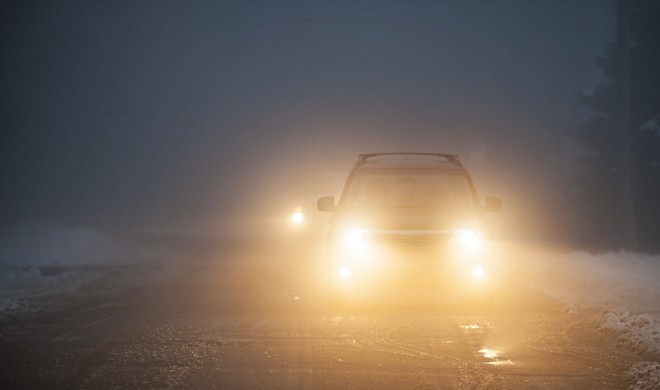
In conditions of insufficient visibility, you need to include:
- low or high beam headlights in motion (see above in the description of lighting in the dark, in which conditions the high beam cannot be used);
- parking lights when stopping and parking - dipped headlights, fog lights or rear fog lights, together with parking lights, can also be turned on in poor visibility conditions (as opposed to the dark time of the day).
- fog lights - only in conjunction with low or high beam headlights (and on roads of any illumination, as opposed to the dark time of the day).
- rear fog lamps (this is the only condition in which they can be used).
In conditions of insufficient visibility, you can not use:
- fog lamps without dipped or main beam headlights;
- daytime running lights.

What kind of light to use in the tunnel?
Traffic rules regulate the obligatory inclusion in tunnels (clause 19.1). The rule here is simple: the conditions for using certain lighting devices are the same as in the dark.
When can I use the emergency gang?
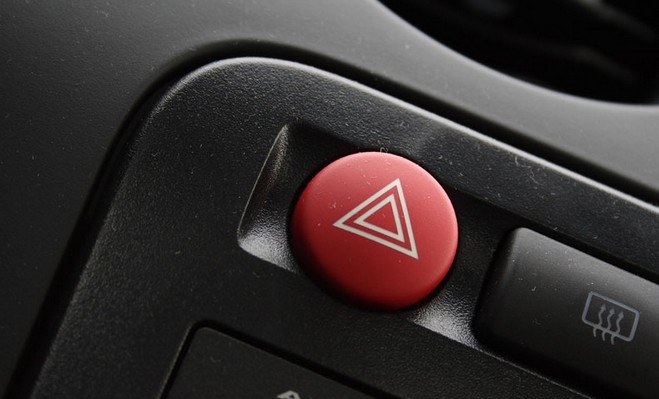
Emergency signaling - this is also considered a light device, and traffic rules clearly regulate the possibility of their use. So, the emergency gang must be turned on:
- in case of an accident along with an emergency stop sign (2.5 SDA + 7.1 SDA);
- when a situation arises when your car is dangerous;
- in case of a forced stop in a place where stopping is prohibited (together with an emergency stop sign);
- when towing in a towed vehicle;
- if you are blinded by oncoming traffic.
When can you blink your headlights?
Yes, most often, drivers blink their headlights (one or several short-term headlights switching from near or DRL to distant) when warning about traffic police officers to oncoming cars. However, traffic rules recommend doing this in completely different cases. In which ones:
- to warn other road users about the start of overtaking;
- if you are blinded by an oncoming vehicle.
At the same time, nowhere in the Rules is there a direct prohibition on blinking headlights. Nevertheless, traffic police officers can regard this as a traffic violation, as a result of which you can easily earn a fine of 500 rubles. Think for yourself, because when you blink, you turn on the main beam, and in most cases it is forbidden to turn it on.
As you can see, everything is very simple! But let's simplify even more these Rules for the use of lighting devices and present everything in a clear tabular form.
| Conditions / light | Bright time | Nighttime, illuminated road sections of settlements | Dark time of day, unlit sections of roads | Tunnel | Insufficient visibility |
|---|---|---|---|---|---|
| Low beam | + | + | + | + | + |
| High beam | - | - | + | + | + |
| Fog lights | + 1 | - | + 2 | - | + 2 |
| Daytime Running Lights | + | - | - | - | - |
| Rear fog lights | - | - | - | - | + |
Table footnotes:
- Instead of dipped headlights
- Only in conjunction with low or high beam headlights
And, finally, an official excerpt from the current traffic rules of 2017, chapter 19 on external lighting devices.
19. Use of external lights and sound signals.
19.1. At night and in conditions of insufficient visibility, regardless of the lighting of the road, as well as in the tunnels on a moving vehicle, the following lighting devices must be switched on:
- on all motor vehicles - high or low beam headlights, on bicycles - headlights or flashlights, on horse-drawn carts - flashlights (if any);
- on trailers and towed motor vehicles - parking lights.
19.2. High beam should be switched to low beam:
- in settlements, if the road is lit;
- in the event of an oncoming passing at a distance of at least 150 m from the vehicle, as well as at a greater distance, if the driver of the oncoming vehicle by periodically switching the headlights shows the need for this;
- in any other cases, to exclude the possibility of dazzling the drivers of both oncoming and passing vehicles.
In case of blindness, the driver must turn on the hazard warning lights and, without changing the lane, slow down and stop.
19.3. When stopping and parking in the dark on unlit sections of the road, as well as in conditions of insufficient visibility, the parking lights on the vehicle must be turned on. In poor visibility conditions, in addition to side lights low beam headlights, fog lights and rear fog lights can be turned on.
19.4. Fog lights can be used:
- in conditions of insufficient visibility with low or high beam headlights;
- in the dark on unlit sections of the road, together with the dipped or main beam headlights;
- instead of dipped headlights in accordance with paragraph 19.5 of the Regulation.
19.5. During daylight hours, dipped-beam headlamps or daytime running lights must be switched on on all vehicles in motion for the purpose of their identification.
19.6. A searchlight and a searchlight may only be used outside built-up areas in the absence of oncoming vehicles. In settlements, such headlights can only be used by drivers of vehicles equipped in the prescribed manner with blue flashing beacons and special sound signals when performing an urgent service assignment.
19.7. Rear fog lights can only be used in poor visibility conditions. It is forbidden to connect the rear fog lights to the brake lights.


